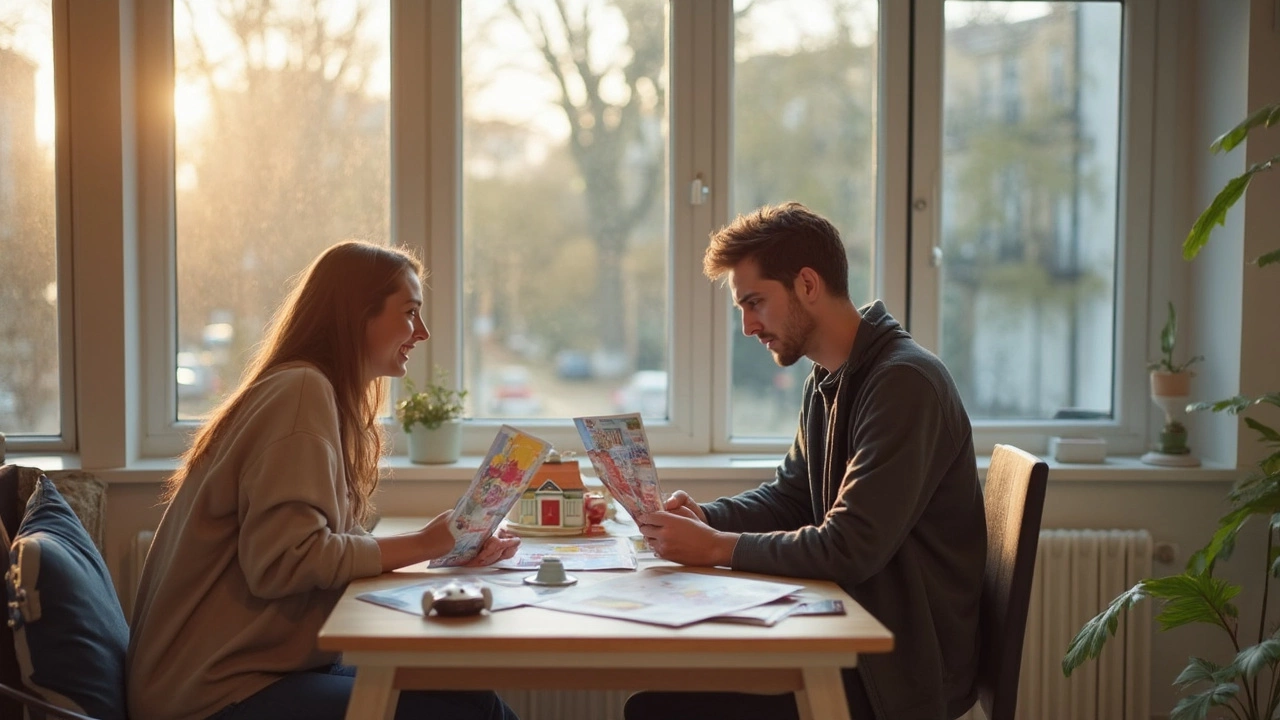Dreaming of owning a home but don’t have a massive chunk of cash? Shared ownership could be your way in, but it can sound a bit confusing at first. Here’s the idea: instead of buying the whole property, you buy a chunk, maybe 25%, maybe 50%—whatever size slice you can afford. The rest? You pay rent on it to a housing association.
This means that even if you can’t save up a massive deposit, you could still call yourself a homeowner (well, part-owner if we’re being precise). You only need a deposit for your share—which is way less scary than putting down one for the whole place. It removes a big hurdle for first-time buyers and those on steady but not sky-high incomes.
- How Shared Ownership Works
- What Owning a Share Really Means
- Costs, Fees, and Your Responsibilities
- Tips for Making Shared Ownership Work for You
How Shared Ownership Works
Here’s the lowdown: shared ownership is a government-backed scheme in the UK that’s been running since the 1980s. If you’re over 18, your household income is under £80,000 a year (or under £90,000 in London), and you don’t already own a home, you might qualify. It targets first-time buyers, people who used to own but can’t afford now, and current shared owners looking to move.
When you buy through shared ownership, you pick your share—usually between 10% and 75%. Let’s say the home’s full price is £300,000, and you buy a 25% share. That’s £75,000 for your chunk. You get a lease on the property, and pay rent on the part you don’t own (to the housing association). Rent isn’t sky-high; it’s typically charged at about 2.75% of the remaining share’s value per year.
Check out this typical breakdown:
| Full Home Value | Your Share % | Your Share Cost | Deposit Needed (5%) | Rent on Remaining Share |
|---|---|---|---|---|
| £300,000 | 25% | £75,000 | £3,750 | ~£515/month |
What’s great is you don’t have to stick with that first share. Most schemes let you “staircase”—buy more shares in the future as you save up, eventually getting to 100% ownership if you want. Staircasing is flexible, but keep in mind you’ll pay for each extra chunk you buy at whatever the home is worth at that time, not what it was when you moved in.
- Buy a share (10% to 75%)
- Pay rent on what you don’t own
- Increase your share over time (staircasing)
- Sell whenever you’re ready—though the housing association gets first dibs
The biggest draw? Less upfront cash needed. But shared ownership isn’t just about money—it brings rules about who can buy, how you sell, and what happens if you want to move on. Knowing how it all fits together means fewer surprises down the line.
So, if getting the keys to your own place sounds impossible, this path could actually open the front door for you. Remember, shared ownership homes aren’t charity houses—think of them as a partnership with the housing association where both sides want to make it work.
What Owning a Share Really Means
So you own, say, 40% of a flat through shared ownership—what does that actually look like? First off, you have a legal claim to that percentage of the home. You can decorate, live there, and make it yours, but you don’t own the whole thing. The rest stays with the housing association, and you pay rent to them for their share.
One big upside: your deposit and mortgage are based only on your share, not the full value of the property. That’s a game changer for affordability. For instance, if the flat is worth £300,000 and you buy a 40% share, you only need a deposit and mortgage for £120,000. That can make the difference between owning and never owning at all.
Here's how it usually breaks down in shared ownership homes:
- You can increase your share (called 'staircasing') later if you want—sometimes up to full ownership if the scheme allows.
- You’re responsible for things like repairs and upkeep, just like any other homeowner. Even if you only own a slice, the whole property’s condition is on you.
- If you decide to move out, you can sell your share. The housing association may get 'first dibs' on finding a new buyer, though.
Don’t confuse this with renting—a shared owner gets a lease (often 99+ years) and the right to live in the place like any homeowner. Your name is on the lease, and you can make it your home for as long as you want, as long as you stick to the agreement and pay your rent.
| Cost Item | 40% Share | 100% Ownership |
|---|---|---|
| Deposit | £6,000 - £12,000 | £20,000 - £40,000 |
| Mortgage (monthly) | £700 | £1,800 |
| Rent (to housing association) | £500 | £0 |
| Service Charge & Fees | £150 | £150 |
As you can see, monthly costs are split between your mortgage and rent. For most people starting out, this makes pulling together a deposit much more doable. Just remember you’re responsible for both payments every month, so budget with that in mind. Shared ownership gives you the rights and responsibilities of an owner but not total free rein—so read every document closely before you commit.

Costs, Fees, and Your Responsibilities
The thing with shared ownership is it’s not just the price of your share—there are a few other numbers to think about. First, you’ll pay for your slice of the property, and you usually need a deposit. The good news: this deposit is based only on shared ownership of the home, not the total price. So if you’re buying a 30% share of a £300,000 home, your deposit could be as little as 5% of £90,000 (£4,500) rather than 5% of the whole £300,000.
Most people take out a mortgage for their share. On top of that, you pay rent on the part you don’t own yet. It might feel weird paying both a mortgage and rent, but the rent is usually cheaper than the local market rate—think around 2.75% of the unsold equity per year.
Don’t forget the extra costs that catch people out. Here’s what you’ll likely need to budget for:
- Rent: Paid to the housing association, based on their share of the property.
- Service charge: For maintenance of shared areas, gardens, and general upkeep.
- Buildings insurance: Usually organized by the housing association, but you pay for it.
- Legal fees: Solicitors or conveyancers handle the legal bits, costing anywhere from £800-£1,500.
- Stamp Duty: Depending on your share size, you might pay Stamp Duty only on your part, or you can choose to pay the full amount upfront.
Here’s a quick table to show how the costs stack up for an average London shared ownership home in 2025:
| Cost Type | Monthly Amount (Typical 30% Share) |
|---|---|
| Mortgage (on 30%) | £430 |
| Rent (on 70%) | £520 |
| Service Charge | £120 |
| Buildings Insurance | £15 |
Your to-do list doesn’t end once you move in. You’re responsible for all repairs inside your flat or house—even if you only own a chunk. If the boiler breaks, it’s on you. The housing association sorts the building’s structure or shared areas, but you’re usually looking after everything inside. There’s sometimes a warranty on new-builds (usually 10 years), but it’s wise to double-check what’s covered.
So, monthly outgoings can add up, but they’re usually less than private renting a similar place. And because you own a share, you’re building up equity—handy if you decide to buy extra shares later or eventually go for 100% ownership.
Tips for Making Shared Ownership Work for You
Getting the most out of a shared ownership setup isn’t just about grabbing the first deal you see. Here’s how you can make sure the move makes sense for your pocket and your peace of mind.
- Start with the basics: Know exactly what percentage of the property you’ll own, and what that means for your monthly payments. The higher your share, the lower your rent on the remaining bit. If you can stretch to a bigger chunk, you’ll save more each month.
- Understand the costs. Besides your mortgage and rent, you’ll likely have to pay service fees, maintenance costs, and sometimes ground rent. Ask for a full breakdown before you sign anything. These costs can add up and surprise a lot of buyers.
- Staircasing, or buying more shares later, is possible—and most people do it. But every time you buy an extra slice, you’ll pay more fees (and possibly a higher price if the property value has gone up). Budget for this if your plan is to eventually own more.
- Check the small print. Some schemes have limits on staircasing or restrict the sale price when you sell on. Get a solicitor who’s done this before to comb through the details so you don’t get stuck later.
- Always check if you’re eligible for any government help or shared ownership schemes. Some regions and cities run their own deals, and it’s silly to miss out on possible savings.
- Keep an eye on your total monthly outgoings—rent, mortgage, and fees lumped together. Housing associations often set a maximum so your total doesn’t go above a set chunk of your income (usually around 45%). Make sure you’re comfortable with the numbers before jumping in.
- If something about the process confuses you, ask—housing associations are used to explaining things over and over. There’s no shame in making sure you know what you’re signing up for.
Remember, shared ownership opens doors, but like any housing deal, it comes with quirks and fine print. Being clear about the details means fewer headaches and more chances to enjoy your new place.
